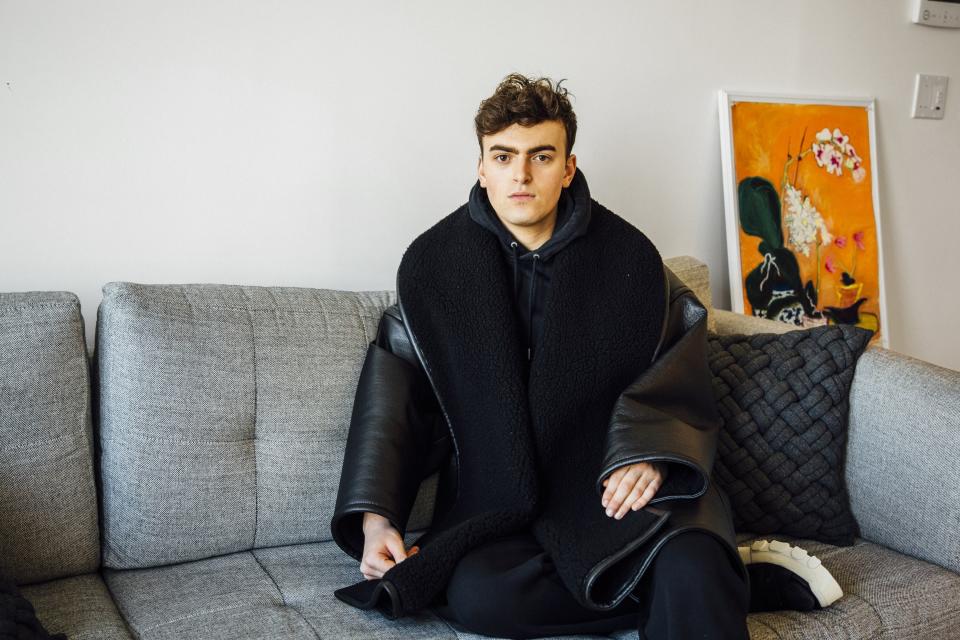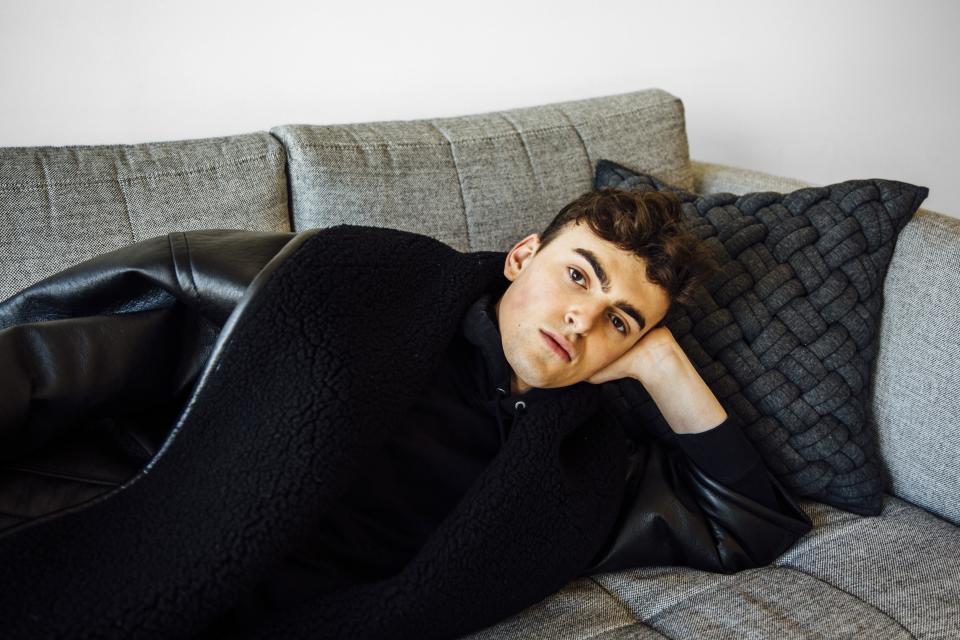How Luke Meagher of Haute le Mode Got His Start on YouTube and in Fashion
For Teen Vogue, fashion is all about giving you a behind-the-scenes look at the industry, thinking deeply about why we wear the things we do, and, of course, finding inspirations for our closets. To kick off NYFW, we are doing just that. In this story, we profile Youtuber Luke Meagher of Haute le Mode.
In 2018, internet sensation and Gen-Z style commentator Luke Meagher, then 20, claimed the fashion industry was f-cked after deciding the style of the 2010s was uninspired and had no identity. Two years later, that sentiment remains. Meagher, known online by the moniker Haute le Mode, is a critic for a new age in fashion, one who digests industry happenings via YouTube videos and Instagram memes. His followers find his sassy and unabashed commentary sharp and hilarious: He’s not afraid to openly call Clare Waight Keller’s print selection at Givenchy “heinous” or suggest that Maria Grazia Chiuri leave Dior before she destroys it.
“I think I’ve always had my voice in that I’ve always been a little bitchy bitch that’s made snarky comments my entire life about people and things I don’t like,” Meagher says of developing his online persona. “I’ve always said really awful, inappropriate things out loud and waited for people’s reactions, so I felt like I just had to find and cultivate that online, but also in terms of fashion. My tagline is ‘fun, sassy, bitchy, analytical.’”
Over the past five years, Meagher has emerged as a fresh, modern voice in fashion at a time when criticism is not taken lightly, a time when it’s commonplace for longtime editors to be banned from attending a designer’s runway shows for expressing a point of view that isn’t overly positive or congratulatory. While he grew up loving fashion, he says he never considered fashion criticism to be a potential career, nor did he admire any of the industry’s mainstays, like Tim Blanks or Cathy Horyn. Sure, his path may be unconventional — Meagher says he was always commenting on what people were wearing to his friends and things just evolved from there — but it also provides those even peripherally interested in fashion with a perspective that’s new and isn’t rooted in decades of experience.
“I originally started Haute le Mode as a street-style blog,” says Meagher, who has a penchant for vintage blazers and simple T-shirts. “‘Haute’ is French for ‘high-class’ and ‘le mode’ is actually Italian; people always say it doesn’t make any sense, and I’m like, I know, it’s not supposed to make any sense! The fact that it doesn’t make sense is so much more on brand.”

While studying abroad in London in 2017, Meagher had the idea to review the Alexander Wang spring 2018 show, a guerrilla-style presentation that involved party buses stopping at different locations in New York City. It was a collection Meagher said was “awful” and likened to an “H&M cut-and-sew project” at a time when Wang was being lauded as a “design genius.” He decided to send that opinion into the ether. That was just the beginning of his mission: to make fashion digestible for everyone through commentary that was relatable and didn’t require extensive industry knowledge or education.
“When I look at a lot of my YouTube contemporaries, they have millions of followers, and a lot of what they do is much more accessible,” Meagher says, referring to the unboxing and haul videos prominent within the platform’s style community. “Fashion is a really complex, convoluted industry that you have to spend time getting to know. Time is really what helped me crack the code. Creating a community definitely wasn’t always easy and fun; you feel really defeated because you’re like, no one’s ever going to care about this. But 325K subscribers later, people do care.”
Some of Meagher’s most successful videos to date include a roundup of the most influential Alexander McQueen shows titled “Alexander McQueen Made Models Do What!?!” (1.1 million views), a review of a Harper’s Bazaar video with Heart Evangelista called “Reacting to a REAL Crazy Rich Asians’ Closet” (941K views), and a roast of the Met gala red carpet (1 million views). In the comments, followers add their own thoughts, engage in insightful discourse, and compliment Meagher on his encyclopedic knowledge of the industry (though that’s something he denies having). As one comment reads: “Your channel is so important. For young people who didn’t live through the ‘90s and really don’t have an idea about the era, your videos allow us to be educated on fashion… there really aren’t any other modern resources like you (at least on YouTube).”
After recognizing an audience existed, Meagher expanded his reach to other platforms, creating a more 360-degree experience. On Instagram, he creates fashion-focused memes; on Twitter, he says he’s having “real conversations between people who may not necessarily know a lot about fashion but have really informative opinions on the industry and collections and designers.” At the moment, he’s experimenting with TikTok.
The common thread, of course, is Meagher’s voice — that and the fact that he isn’t afraid to piss someone off, mostly because he still considers himself an outsider.
“For me personally, because I am so removed [from the industry], I’m not just going to go around and say, ‘Everyone’s great! Please invite me to your show.’ It’s not fun having to critique people you really enjoy or know personally, but you have to be fair. It’s very hard because it makes you unpopular as well. At first, I was like, I’ve always wanted to be the industry person everyone likes, but unfortunately, my job is a job that not everyone will enjoy. And I’ve come to terms with that.”

Currently finishing his studies in advertising and marketing communications at FIT (he has one class remaining), Meagher plans on turning Haute le Mode into his full-time job and a viable source of income; though his major hasn’t necessarily provided him much insight into the fashion industry, he says, it has taught him how to run a business. But monetizing a platform that criticizes the industry and its players, particularly the ones who oftentimes serve as its biggest advertisers, is tricky, and something Meagher’s internet peers, like Instagram watchdog Diet Prada — which holds fashion designers and publications responsible for the messages they convey — have found difficult to navigate. Is it possible to remain impartial while also working directly with the companies being critiqued?
“Moving forward, I’ll work with a brand if they understand what I do,” Meagher says. “I have no problem going to a Gucci show if they sit me front row; I want to sit front row, not as a status symbol, but because they actually respect my ideas and want my genuine feedback. If you don’t invite me backstage, if you don’t invite me to the re-sees, why would I want to work with you? Also, if you don’t respect the critique you’ve asked for, then I don’t want to work for you. Brands need to understand that a critique isn’t a bad thing,” he says, adding that it provides designers with external insight that could help better shape their brand and connect with customers going forward. “It’s about staying as impartial as possible and as true to me; I don’t have the backing of brands, publicists, or editors. I have the backing of the people who like what I do and watch my videos.”
Ultimately, Meagher sees his job as translating everything that’s happening in the industry (“from Air Diordans to the cornrows at Comme des Garcons, which were gross and racist”), connecting fashion and its history to culture today, and highlighting what needs to change.
Currently, the fashion industry is at a crossroads: Fashion Week is in decline, print publications are shuttering at record rates, and most women are gravitating toward athleisure over ready-to-wear. “For me, [the fashion industry] right now is sad to watch because I feel like we could be having this beautiful renaissance,” Meagher says. “But people just aren’t allowing it to happen because they are stubborn and afraid of what’s next.”
He continues: “When Cristóbal Balenciaga started out, he was not running a fuddy-duddy old brand that made sock sneakers; he was a revolutionary couturier of his time. I think there are very few designers that are pushing not just the knowledge of cutting and sewing and draping but the ideas of textile design and crafting something we haven’t seen before. The industry is so into itself that it won’t allow itself to grow. Fashion is supposed to lead us in terms of what is cultural, what is new, what is interesting, and we just don’t have that from these big luxury houses.”
It’s that desire for something different that drives Meagher to present the industry at face value. He isn’t just critiquing collections; he’s calling out fashion’s shortcomings, including its lack of diversity and inclusivity, its continued mishaps with cultural appropriation, and its surface-level commitments to a more sustainable future.
“Brands can’t just fly everyone out to Paris to see [their shows] and say they’ll plant trees to be carbon neutral,” he says of the sustainability question. But what it comes down to, in Meagher’s opinion, isn’t just a lack of awareness — it’s an absence of innovation.
“[Why can’t designers] figure out a new fabric, or figure out a way to strip old clothing straps and turn it into yarn? They’re meant to be the creatives of this industry, and yet here we are! They’re all stuck in the same shit, referencing the ’60s, ’70s, ’80s, and ’90s every season. Why don’t they invent something new? Not to be super fucking cocky, but I created a new way to talk about fashion by myself! So why can’t any of them do that with their hundreds of employees, publicists, and dollars?”
Originally Appeared on Teen Vogue

